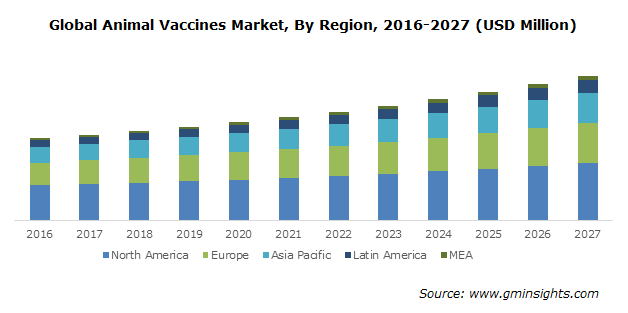Home > Animal Health & Nutrition > Veterinary Pharmaceuticals > Animal Vaccines Market
Animal Vaccines Market Analysis
- Report ID: GMI3117
- Published Date: Aug 2021
- Report Format: PDF
Animal Vaccines Market Analysis
The farm animal vaccines market was valued at USD 5.49 billion in 2020 led by the increasing prevalence of zoonoses among farm animals. Several zoonoses such as leptospirosis, Johne’s Diseases (JD), viral respiratory tract infections, bovine ephemeral fever, and infectious bovine rhinotracheitis (IBR) among others affect farm animals worldwide and increase the disease burden. Rising prevalence of these conditions is predicted to augment the demand for animal vaccines, thereby stimulating the industry progression during the forecast timeframe.
The live attenuated vaccines segment accounted for around 44% of the market share in 2020 impelled by the high clinical efficacy as compared to inactivated vaccines. Majority of the commercially available veterinary vaccines are live attenuated vaccines. These vaccines are capable of inducing humoral as well as cell-mediated immune responses, thereby offering long-term effectivity. These vaccines are also known to induce higher immunogenicity and often, a single vaccine dose is sufficient to provide long-term protection. Live attenuated vaccines are highly preferred in emerging economies owing to high cost-effectivity as compared to other vaccines.
The viral vaccines segment will reach USD 6.34 billion by 2027 due to the growing prevalence of viral infections globally. The rising demand for meat has led to intense production, with livestock farms housing animals in high densities that prove conducive to rapid pathogen transmission and result in endemic infectious diseases. According to the World Organization for Animal Health (OIE), from 2016 to 2020, notable increase in African swine fever (ASF) outbreaks were reported in African, European, and Asian region. The viral disease was present in 60 countries and accounted for 8,202,702 swine deaths. In the first five months of 2021, the authorities in Poland reported an exponential 520% increase in ASF outbreaks in domestic pig herds. The constant threat posed by the endemic and emerging viral disease has led to the development of viral vaccines offering clinical effectiveness.
The injection vaccines segment captured USD 4.57 billion in 2020. Intramuscular or subcutaneous is the dominant route of vaccine administration in animals and is prioritized for diseases requiring systemic immunity. This approach optimizes the vaccine immunogenicity and reduces potential adverse reactions at the injection site. Several clinical studies have showcased the immunological benefit of injectable vaccines with minimal local side effects. Administering vaccine through injection also helps in ensuring the appropriate dosage. The development of novel mRNA vaccines that are administrated using the intramuscular approach has aided in driving clinical efficacy. Multiple studies have reported that vaccines administered through injections offer better efficiency and high humoral & cellular immune responses with a comparatively long duration of effect.

U.S. dominated the North America animal vaccines market and will cross USD 4.20 billion by 2027 on account of the several factors such as growing acceptance of pets, high pet care expenditure, and a rise in the incidence of zoonotic diseases across the country. According to the American Pet Products Association's 2017-2018 National Pet Owners Survey, there were more than 89 million pet dogs and 94 million pet cats in the U.S. households. The veterinary care expenditure surged from USD 48.35 billion in 2010 to USD 75.38 billion in 2019 and is unparalleled as compared to the other countries. The growing pet adoption and high pet care expenditure are set to increase the demand for animal vaccines, further facilitating the industry revenue.

